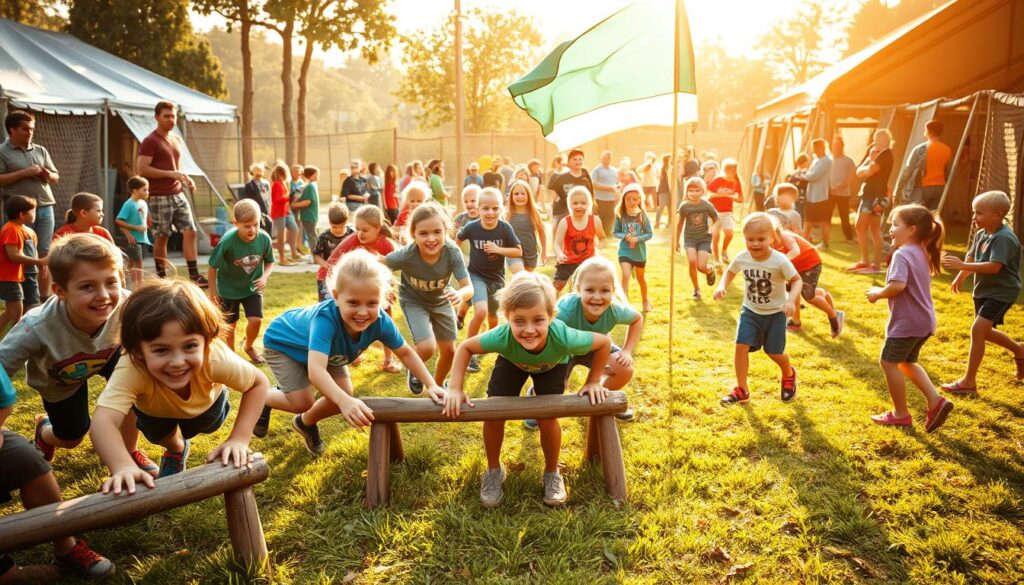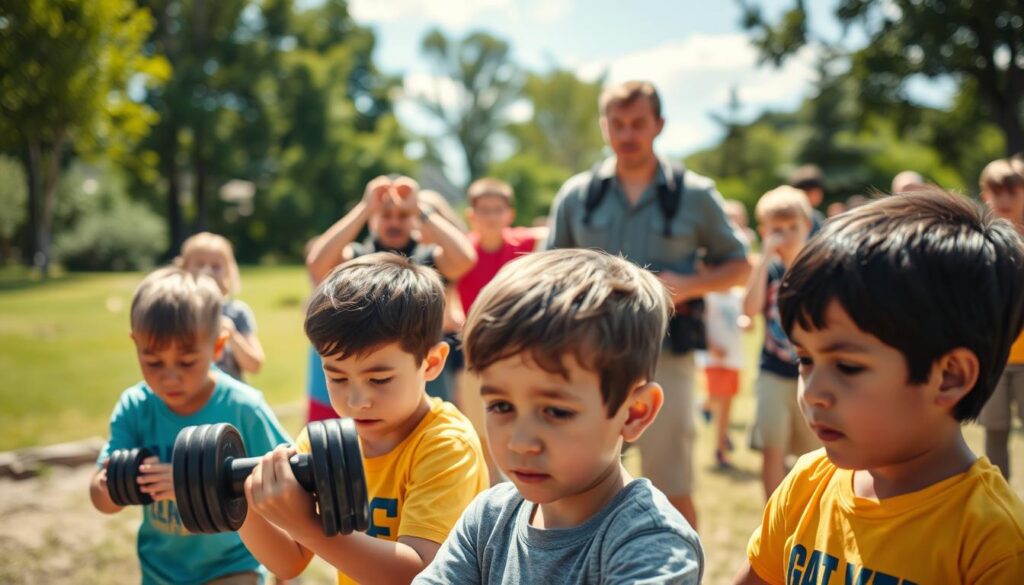Have you ever wondered how to help your child grow into a confident, healthy, and socially engaged individual? Modern programs designed for young participants offer a unique blend of structure and enjoyment, focusing on character development, physical health, and social engagement.
Unlike outdated military-style models, these programs emphasize a balanced approach. They incorporate activities that build resilience while ensuring kids have fun. One growing trend is the integration of wilderness therapy, which combines outdoor adventures with personal growth opportunities.
These programs are gaining popularity for their ability to nurture well-rounded individuals. They provide a safe space for kids to learn, grow, and thrive. Whether it’s through teamwork challenges or fitness activities, the focus is always on holistic development.
Key Takeaways
- Modern programs blend structure with enjoyment for kids.
- Core focus areas include character development, physical health, and social engagement.
- Outdated military-style models are being replaced by balanced approaches.
- Wilderness therapy is a popular addition to these programs.
- These programs are designed to nurture well-rounded individuals.
What is a Boot Camp for Kids?
How do structured environments help youth develop essential life skills? Modern programs are designed to create a balanced mix of discipline, fitness, and fun. These environments focus on building resilience, improving mental health, and fostering positive behavior.
Definition and Purpose
Today’s programs are structured skill-building environments. They aim to help youth grow through outdoor challenges and teamwork. Unlike traditional models, these programs emphasize personal growth over punishment.
The purpose is to teach life skills like discipline, responsibility, and collaboration. Activities often include physical training, problem-solving tasks, and group projects. These elements work together to create a well-rounded experience.
Historical Background
The origins of these programs trace back to the 1980s. During this time, there was a 35% increase in juvenile detentions. This rise led to the creation of early correctional models.
By 1983, Georgia introduced the first adult program. Over time, these models evolved into therapeutic approaches. Today, 10 states operate similar programs for youth, focusing on rehabilitation and growth.
Modern programs contrast sharply with “juvenile boot camps,” which are often correctional. Instead, they prioritize mental health and positive behavior. This shift reflects a broader understanding of what youth need to thrive.
Benefits of Boot Camps for Kids
Engaging in structured activities can significantly enhance a child’s overall development. These programs are designed to build resilience, foster teamwork, and instill lifelong habits. By combining physical challenges with mental growth opportunities, they create a balanced environment for success.
Physical Fitness and Health
Daily activities like calisthenics and obstacle courses improve physical health. These exercises help maintain healthy BMI metrics and boost energy levels. Regular training also encourages a positive relationship with fitness, setting the foundation for a healthy lifestyle.
Discipline and Self-Control
Structured routines teach emotional regulation and self-control. Techniques like cognitive behavioral therapy are often integrated to help youth manage stress and make better decisions. This focus on discipline prepares them for challenges in school and beyond.
Social Skills and Teamwork
Group challenges, such as raft-building exercises, foster leadership and collaboration. These activities encourage communication and problem-solving skills. By working together, participants learn the value of teamwork and shared goals.
Overall, these programs provide a supportive environment for growth. They combine physical training, emotional education, and social development to create well-rounded individuals. The skills learned here extend far beyond the program, setting the stage for long-term success.
Types of Boot Camps for Kids
Understanding the different types of programs available helps parents make informed decisions. Each program has a unique philosophy and approach, tailored to meet specific needs. Whether focusing on discipline, outdoor adventures, or physical fitness, these programs aim to foster growth and development.
Military-Style Boot Camps
These programs often feature drill instructors and structured routines. They emphasize discipline and physical training, but some models have faced criticism for harsh methods. Research shows that “shock incarceration” approaches can lead to high PTSD rates. Parents should look for programs with a balance of structure and support.
Wilderness Therapy Programs
Wilderness therapy combines outdoor adventures with therapeutic practices. These programs often include licensed counselors and academic components. For example, NIJ-funded programs incorporate 3-hour daily academic sessions. ACA-accredited programs also adhere to strict safety standards, ensuring a secure environment for participants.
Sports and Fitness Camps
Designed for active youth, these camps focus on physical health and teamwork. Many use NCAA-inspired training regimens to build endurance and skills. Activities like obstacle courses and team sports encourage collaboration and leadership. These programs are ideal for children who thrive in competitive, energetic settings.
Choosing the right program depends on your child’s needs and goals. Whether it’s wilderness therapy, military-style discipline, or sports-focused training, each option offers unique benefits. Always research and visit programs to ensure they align with your expectations.
How Boot Camps Promote Discipline
Structured environments play a crucial role in shaping young minds and behaviors. These settings help participants develop essential life skills through a combination of routines, positive reinforcement, and guidance from trained professionals.
Structured Routines
One of the key elements in promoting discipline is the implementation of structured routines. These routines often include military-style schedules, such as reveille and mess times, which teach time management and responsibility. By adhering to a set schedule, participants learn the importance of punctuality and organization.
Behavior Modification Techniques
Behavior modification techniques are integral to these programs. Positive reinforcement systems, like merit badge rewards, encourage good behavior and motivate participants to strive for excellence. Additionally, daily reflection journals are used to help individuals assess their actions and progress, fostering self-awareness and accountability.
Role of Mentors and Instructors
The staff plays a vital role in guiding participants through their journey. Trained in trauma-informed care and de-escalation tactics, mentors and instructors provide a supportive environment. Post-program, participants are often paired with Big Brother/Sister mentors to ensure continued growth and development.
Evidence-based methods, such as those highlighted in the Caliber Associates study, show significant reductions in recidivism rates. For example, Cleveland saw a 33% rate compared to Mobile’s 11.5%, underscoring the effectiveness of these programs in promoting long-term positive behavior.
Fitness Activities in Boot Camps
Structured fitness programs offer a dynamic way for youth to build strength and confidence. These activities are designed to progress from basic to advanced challenges, ensuring participants grow both physically and mentally. Whether it’s through morning workouts or weekend adventures, the focus is on holistic development.
Physical Training Exercises
Morning sessions often include HIIT workouts tailored to different age groups. For example, 12-15-year-olds might focus on foundational exercises, while 16-18-year-olds tackle more advanced routines. These exercises improve physical fitness and teach discipline through structured training.
Outdoor Adventures
Weekend backpacking trips with orienteering challenges are a highlight of these programs. Participants learn wilderness first aid and survival skills, enhancing their problem-solving abilities. These outdoor adventures also foster a deep appreciation for nature and teamwork.
Team Sports and Competitions
Organized events like color wars and capture-the-flag tournaments encourage collaboration and leadership. These team sports activities are designed to build camaraderie and competitive spirit. Progress is tracked using wearable fitness tech, synced to parent apps for real-time updates.
From morning workouts to weekend adventures, these programs create a balanced environment for growth. They combine physical challenges with mental and social development, setting the stage for lifelong success.
Fun Activities in Boot Camps
What makes structured programs engaging for young participants? Beyond discipline and fitness, these programs incorporate a variety of fun activities that foster creativity, teamwork, and personal growth. From arts and crafts to outdoor adventures, these activities are designed to balance structure with creative expression.
Creative Arts and Crafts
Nature art projects using foraged materials encourage participants to connect with their surroundings. These activities not only spark creativity but also teach resourcefulness. For example, creating sculptures from leaves and stones helps build problem-solving skills.
Games and Challenges
Team-based escape room challenges and capture-the-flag tournaments are popular among participants. These games promote social competence by encouraging communication and collaboration. Such activities also help youth develop leadership and strategic thinking.
Campfires and Storytelling
Campfire sessions, often integrated with cognitive restructuring techniques, provide a space for reflection and bonding. Participants share stories, learn about constellations during night hikes, and engage in talent shows. These moments create lasting memories and strengthen group dynamics.
Legacy projects, like trail maintenance markers, allow participants to leave a positive impact on their environment. These activities combine fun with purpose, ensuring a well-rounded experience that extends beyond the program.
Choosing the Right Boot Camp for Your Child
Selecting the ideal program for your child requires careful consideration and research. The right choice can significantly impact their growth, development, and overall experience. Parents must evaluate various factors to ensure the program aligns with their child’s needs and goals.
Assessing Your Child’s Needs
Start by understanding your child’s unique requirements. Consider their physical, emotional, and social needs. For example, a child with specific challenges may benefit from therapeutic programs that focus on mental health and behavior modification.
Use tools like the PARQ assessment (Physical Activity Readiness Questionnaire) to gauge their readiness for physical activities. This step ensures the program’s activities are safe and suitable for your child’s fitness level.
Researching Camp Options
Look for programs with ACA accreditation, which ensures high standards of safety and quality. Research counselor-to-camper ratios; a 1:4 ratio is ideal for personalized attention. Verify certifications, such as wilderness first responder training, to ensure the staff is well-prepared for emergencies.
Additionally, check for JCAHO accreditation in therapeutic programs to ensure they meet rigorous healthcare standards. Programs like those in Maryland were closed due to a 10% recidivism rate, highlighting the importance of thorough research.
Visiting and Evaluating Camps
Schedule visits to potential programs to observe the environment firsthand. Test food allergy protocols to ensure your child’s safety. Ask about the inclusion of an academic program to support their educational needs during the camp.
During the visit, assess the facilities, activities, and overall atmosphere. A well-maintained and supportive environment is crucial for your child’s success and enjoyment.
By following these steps, you can make an informed decision that sets your child up for a positive and transformative experience.
Boot Camp for Kids vs. Juvenile Boot Camps
Understanding the distinction between voluntary and court-mandated programs is crucial for parents. While both aim to instill discipline, their methods and outcomes differ significantly. Voluntary programs focus on personal growth, while juvenile boot camps often emphasize correctional measures.
Key Differences
Voluntary programs are designed for personal development, offering activities that build resilience and teamwork. In contrast, juvenile boot camps are typically court-ordered and focus on behavior modification. A 1996 Michigan law mandates a 6-month aftercare program for participants, highlighting the structured nature of these alternative approaches.
Effectiveness and Outcomes
Research shows mixed results. An NIJ study found no reduction in recidivism rates in Denver and Mobile, while Cleveland saw a 25% increase. Programs like those in Maryland, with 157 participants, contrast sharply with Louisiana’s 400-bed facilities. These differences underscore the importance of choosing the right treatment approach.
Parental Considerations
Parents should be wary of “scared straight” tactics that lack clinical support. Instead, look for programs that include family therapy components. Visiting potential programs and evaluating their safety standards can help ensure a positive experience for your child.
Common Misconceptions About Boot Camps
Many parents have concerns about structured programs, but understanding the facts can ease those worries. These programs are often misunderstood, with some believing they rely on harsh methods or cause harm. In reality, modern approaches focus on positive growth and development.
Myth vs. Reality
One common misconception is that these programs use a “break them down” philosophy. According to AACAP position papers, this approach is outdated and ineffective. Instead, programs now emphasize building resilience through supportive environments.
Another myth is that these programs worsen mental health issues. Research shows that 23% of alumni from poorly managed programs report PTSD risks. However, well-structured programs with licensed professionals can actually improve mental health outcomes.
Addressing Parental Concerns
Parents often worry about the safety and effectiveness of these programs. A Mobile County case study highlights an 87% completion rate, demonstrating their potential for success. Programs that include family therapy and follow-up care show even better results.
Neuroimaging data also supports the benefits of these programs. Studies reveal improved prefrontal cortex development, which is crucial for decision-making and emotional regulation.
Success Stories
Success stories from participants, like a Texas Youth Commission graduate, showcase the transformative power of these programs. This individual credits the program with helping them develop discipline and a positive outlook on life.
A 2022 JAMA Pediatrics study further supports these outcomes, particularly in wilderness therapy programs. Participants showed significant improvements in emotional well-being and social skills.
By focusing on evidence-based methods and positive reinforcement, these programs offer a safe and effective way for youth to grow and thrive.
What to Expect During and After Boot Camp
What does a typical day look like in a structured program for youth? These programs are designed to provide a balanced mix of discipline, fitness, and personal growth. From early morning routines to evening reflections, every activity is carefully planned to maximize development.
Daily Schedule and Activities
A typical day starts at 5:30 AM with morning exercises to build physical fitness. Breakfast is followed by team-building activities and skill-building workshops. Afternoons often include outdoor adventures or academic sessions to support educational growth.
Evenings are reserved for group discussions and reflection. By 9:00 PM, participants wind down with mindfulness exercises. This structured routine helps youth develop time management and self-discipline.
Aftercare and Follow-Up
Post-program support is crucial for lasting success. The OJJDP model recommends 6-9 months of supervised aftercare. This includes family workshops during reunion weekends to strengthen relationships and provide ongoing guidance.
Relapse prevention strategies are also integrated, especially for issues like substance abuse or tech addiction. These measures ensure participants continue to thrive after the program ends.
Long-Term Benefits
The impact of these programs extends far beyond the initial experience. Alumni surveys show significant improvements in GPA over an 18-month period. Many participants also report higher college attendance rates, with 85% enrolling in higher education within five years.
These long-term benefits highlight the program’s effectiveness in fostering personal growth and academic success. By providing a supportive environment, these programs set the stage for a brighter future.
Conclusion
Choosing the right program for your child’s growth requires careful evaluation and trust in the process. Focus on three key pillars: safety, accreditation, and evidence-based methods. Programs with licensed clinicians, like those offering wilderness therapy, ensure a supportive and effective environment.
Be cautious of unregulated programs that rely on outdated “behavior modification” techniques. These can do more harm than good. Instead, opt for therapeutic programs that prioritize mental health and personal development.
Before enrolling, consider a psychological evaluation to assess your child’s needs. For guidance, contact the NACAC referral hotline at 1-800-TO-ADOPT. They can help match your child with a program that fits their unique requirements.
Ready to take the next step? Schedule a free consultation to find the perfect program for your child’s growth and success.
FAQ
What is the purpose of a boot camp for kids?
These programs aim to promote physical fitness, discipline, and teamwork through structured activities and routines. They help youth develop self-control and social skills in a supportive environment.
Are there different types of boot camps for children?
Yes, options include military-style programs, wilderness therapy, and sports-focused camps. Each type offers unique activities tailored to specific goals, such as fitness, behavior modification, or outdoor adventure.
How do these programs promote discipline?
Through structured routines, behavior modification techniques, and guidance from mentors, participants learn accountability and self-control. These methods help instill positive habits and decision-making skills.
What kind of fitness activities are included?
Programs often feature physical training exercises, outdoor adventures like hiking, and team sports. These activities improve health, build endurance, and encourage teamwork.
Are there fun activities in boot camps for kids?
Absolutely! Many programs include creative arts, games, campfires, and storytelling to balance discipline with enjoyment. These activities foster creativity and camaraderie among participants.
How do I choose the right program for my child?
Assess your child’s needs, research options, and visit potential camps to evaluate their environment and staff. Look for programs that align with your goals and your child’s interests.
What’s the difference between boot camps for kids and juvenile boot camps?
Programs for kids focus on fitness, discipline, and fun, while juvenile boot camps often address behavioral issues or legal problems. The latter may involve stricter rules and rehabilitation goals.
What should I expect after my child completes a program?
Many programs offer aftercare support to reinforce skills learned. Long-term benefits often include improved behavior, better physical health, and enhanced social abilities.
Are boot camps effective for troubled youth?
While some programs can help, wilderness therapy or specialized treatment may be more effective for youth with mental health or substance abuse issues. Always consider professional advice when addressing serious concerns.
What are common misconceptions about these programs?
Some believe they are overly harsh or only for troubled youth. In reality, many focus on positive reinforcement, fitness, and skill-building in a supportive environment.







